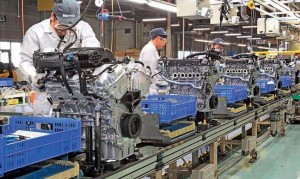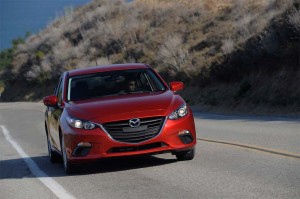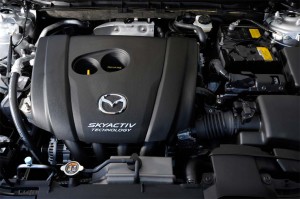With its highway fuel economy estimated at 41 mpg, the new Mazda3 is one of the most efficient models in the U.S. compact segment, the maker giving much of the credit to its new SkyActiv-G powertrain.
Mazda is quickly shifting most of its products to the new SkyActiv engine family and is even on track to become the first Japanese maker to offer a diesel in the U.S. market when the SkyActive-D powertrain debuts early next year. But while the Japanese maker is quick to point out the various technologies that help the various SkyActiv engines deliver the seemingly conflicting benefits of better performance and improved mileage, the real breakthrough may be in the way that the new motors are being produced.
Untethered from its long-running relationship with Ford Motor Co., Mazda has had to completely rethink its business strategy, particularly at the manufacturing level. And when it comes to building engines it abandoned a traditional approach that required massive investments and yielded little flexibility.

The new Mazda plant requires just four maching steps for each SkyActiv engine, rather than 45 with the old MZR engine.
With the SkyActiv program, the maker was able to slash fixed investments by 70%, according to Vehicle Evaluation Manager David Coleman, even while boosting both productivity and flexibility. The new approach allows Mazda to produce an array of new gas and diesel engines on the same line in less than a quarter of the time it used to require for the previous engine family.
“The machines are cheaper, you need fewer machine and the machines move faster,” the Mazda North America executive explains.
(2014 Mazda3 and Mazda6 models both on “short list” for North American Car of the Year. Click Here for the other car and truck nominees.)
Traditionally, powertrain manufacturing is one of the costliest and least flexible elements of vehicle manufacturing. After the basic engine block is cast it must move down a fixed line where, in the case of the old Mazda MZR family of four-cylinder motors, there were 45 individual machining processes required.
The new SkyActiv inline-four engines require just three. The key is a shift to computer numerical control, or CNC, machining. These are highly flexible, essentially robotized machines that can switch their tools on the fly.
As a block rolls down the line, the machine scans its bar code to determine, among other things, the correct displacement so it can switch to the right boring tools. But rather than complete just one step before the engine moves on to another fixed workstation, the CNC machines each can handle a number of distinct manufacturing steps.
(Mazda, Nissan, order major recalls. Click Herefor details.)
Ultimately, that helped reduce the investment in the SkyActiv engine plant by 70%, notes Coleman, adding that where the old system took about 6 hours to produce each MZR engine, a new SkyActiv motor, such as the 2.0-liter base I-4 in the Mazda3, can be completed in just 1.3 hours.
Currently, Mazda has only designed four-cylinder versions of the SkyActiv, but it could “theoretically” produce a V-6 if it found the need, according to Coleman.
(2014 Mazda6 scores “advanced” rating in new IIHS forward crash avoidance test. Click Here to find out why.)
The new approach to engine manufacturing is helping Mazda compensate for the break-up of its alliance with Ford and the concurrent economies of scale benefits that the partnership previously afforded.
New manufacturing methods “have changed so much in recent decades you don’t need economies of scale as much as you did in the past,” the executive contends.
Not entirely, but there are some benefits, especially when it comes to purchasing vehicle componentry. Suppliers are still cutting better deals with manufacturers who buy parts by the millions, rather than in the 100s of thousands. But Mazda is hoping to offset that disadvantage with the savings it anticipates from the new SkyActiv engine line.



It’s misleading to say the new engine machining line uses only (4) machining steps vs. the previous production that used (45) steps. The new system just consolidates the machining operations to three or four machines but there are still the same relative number of machining operations per se required per engine.
CNC machinery is changing all manufacturing because of it’s flexibility. This benefit is not free however as there are disadvantages to “universal” or flexible machining vs. dedicated operations machining.